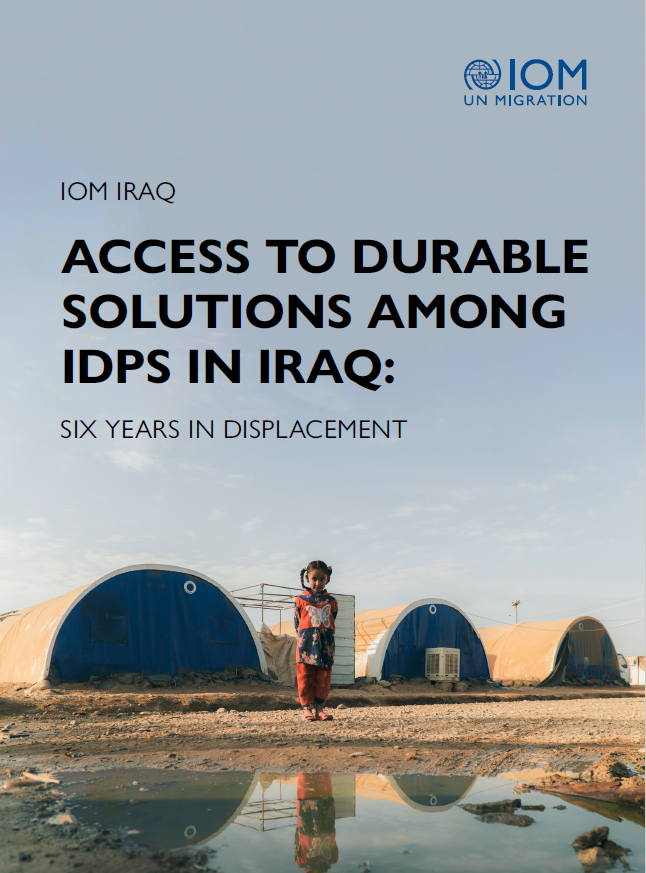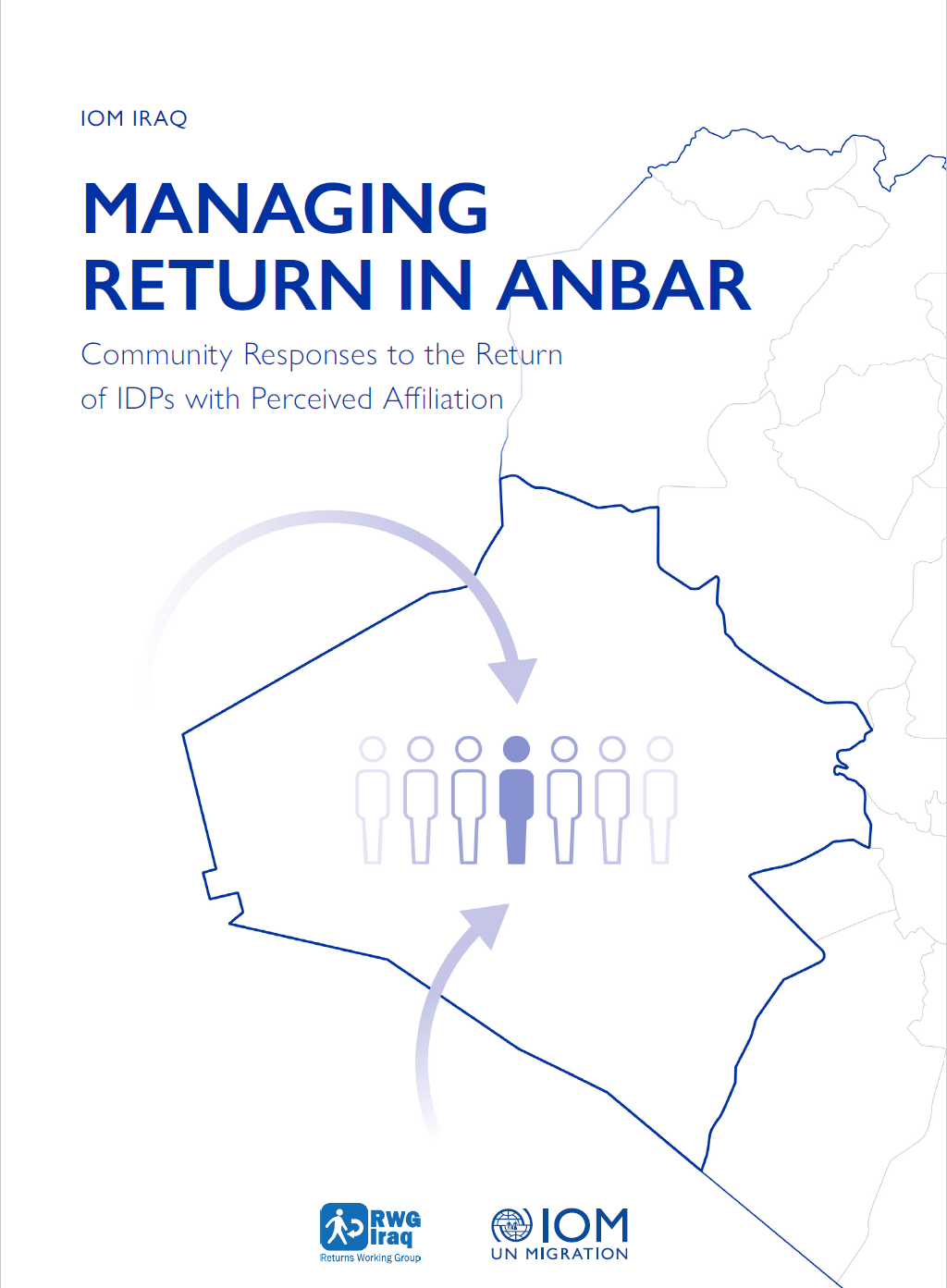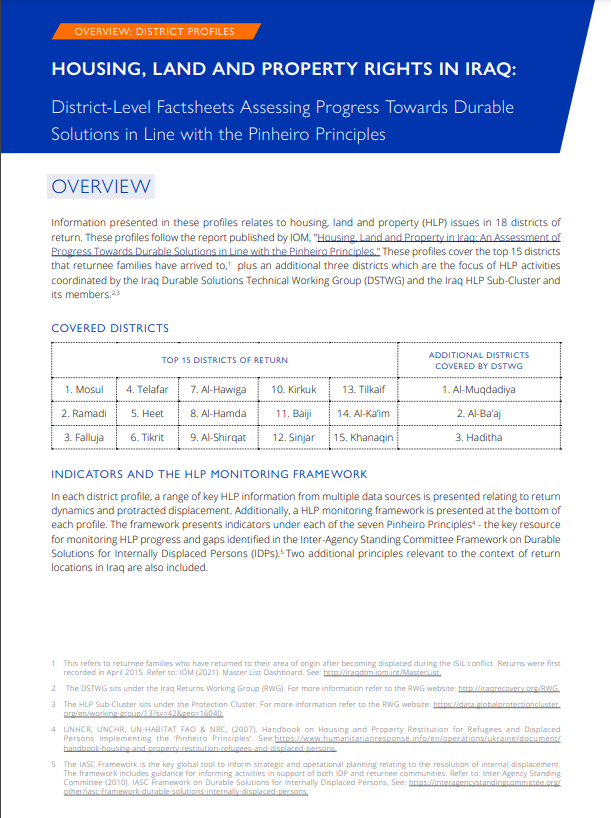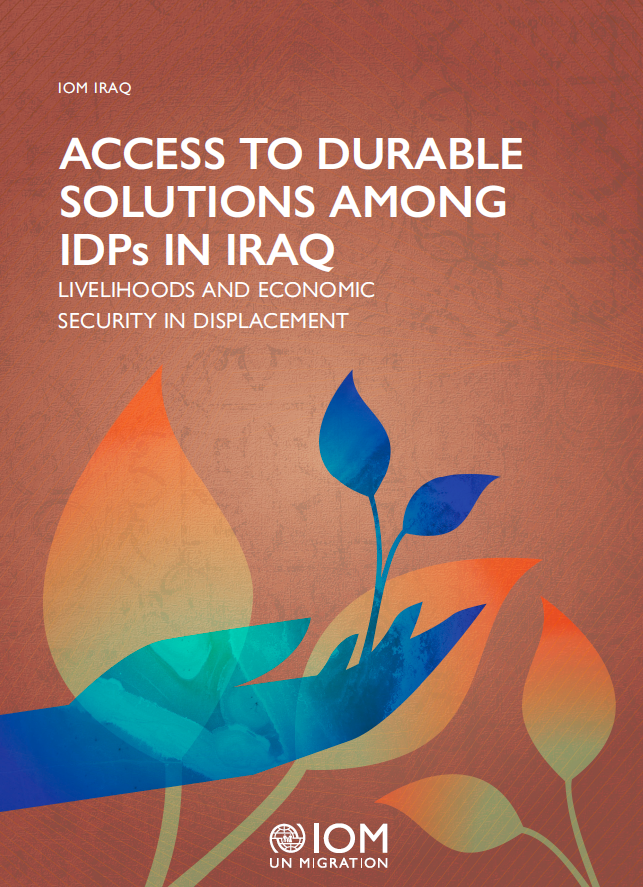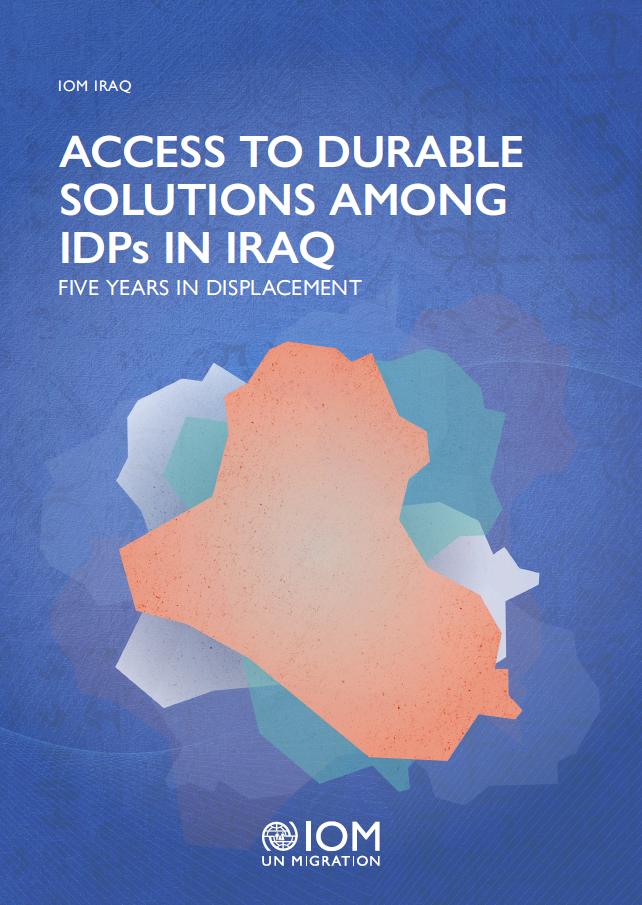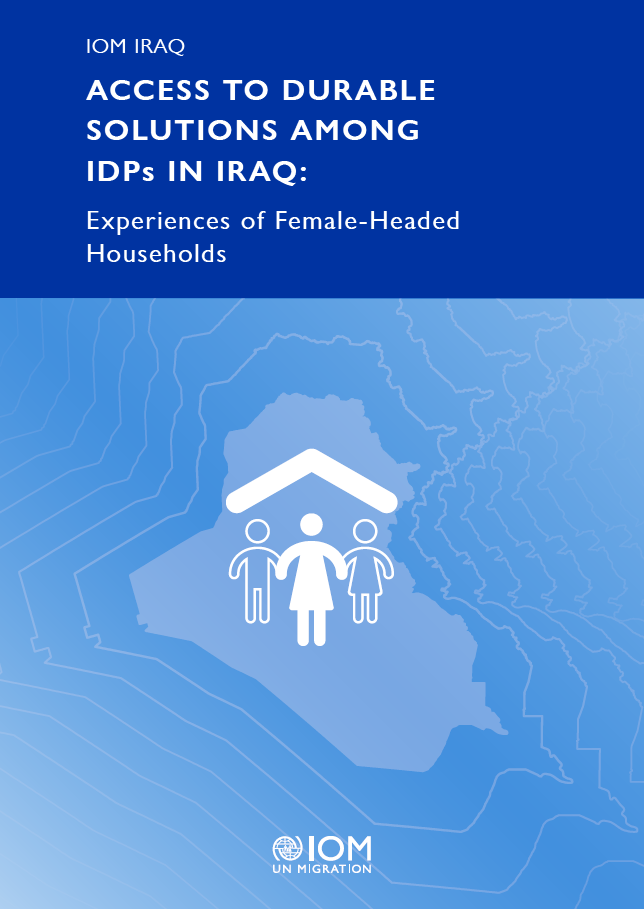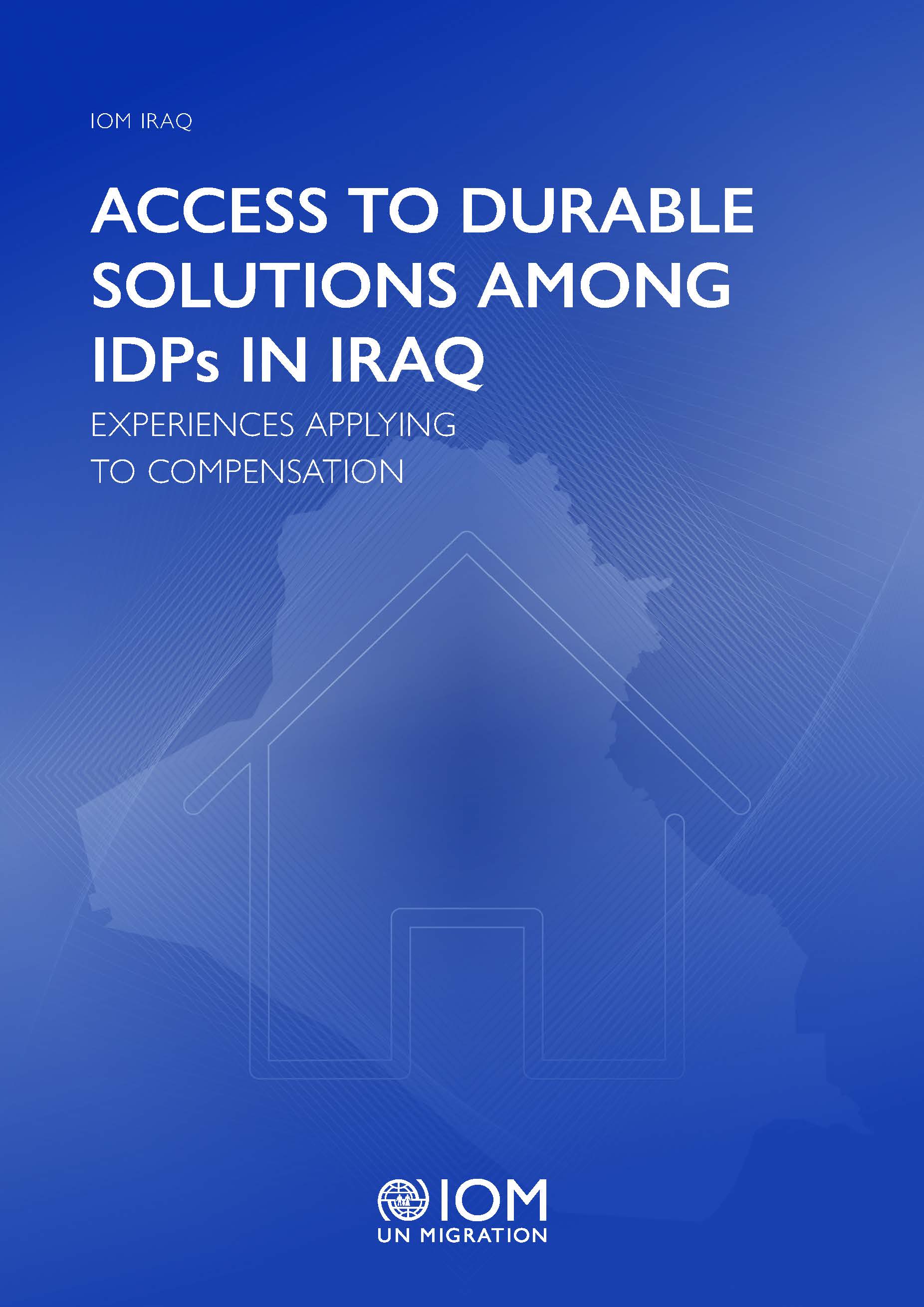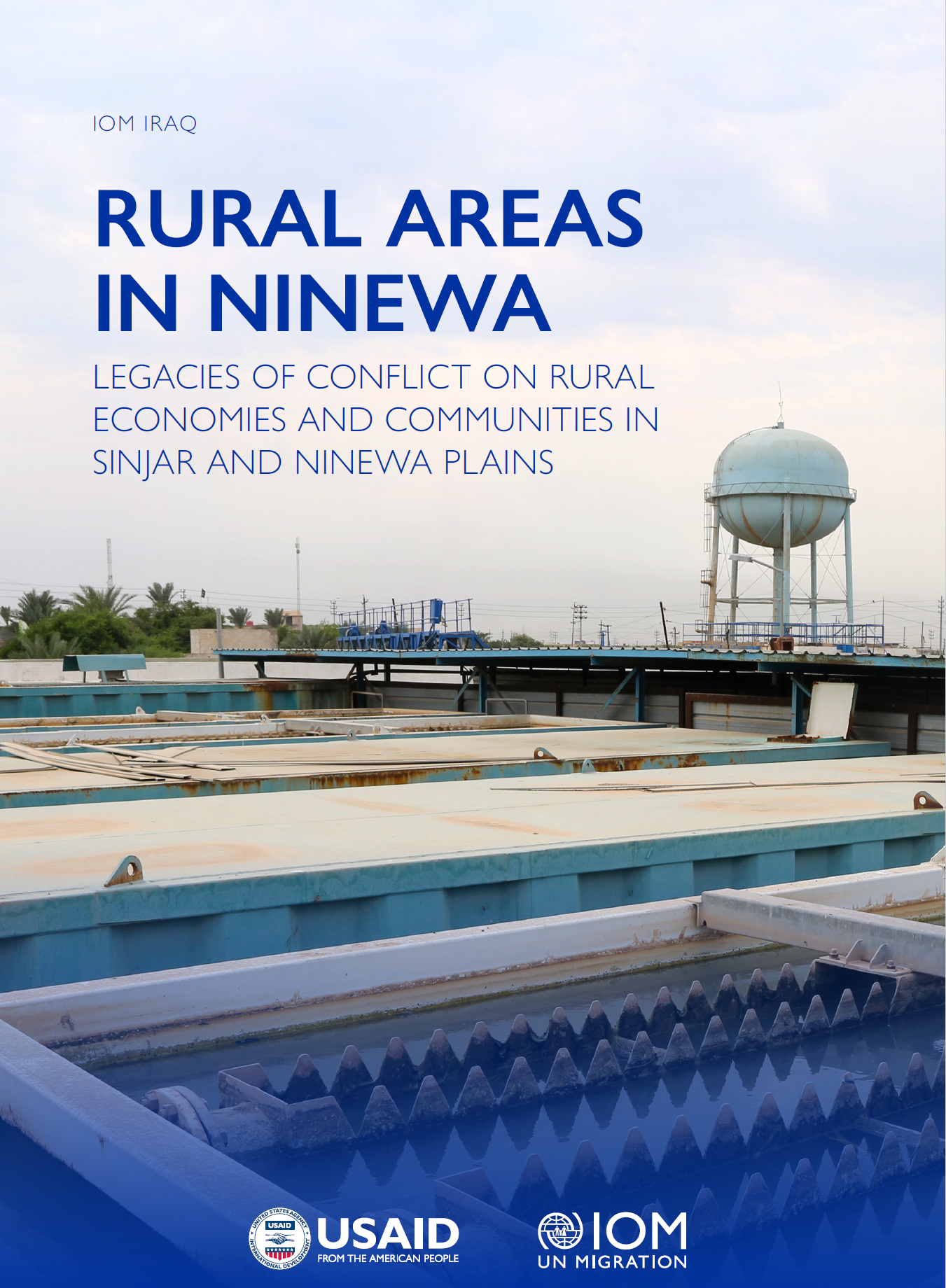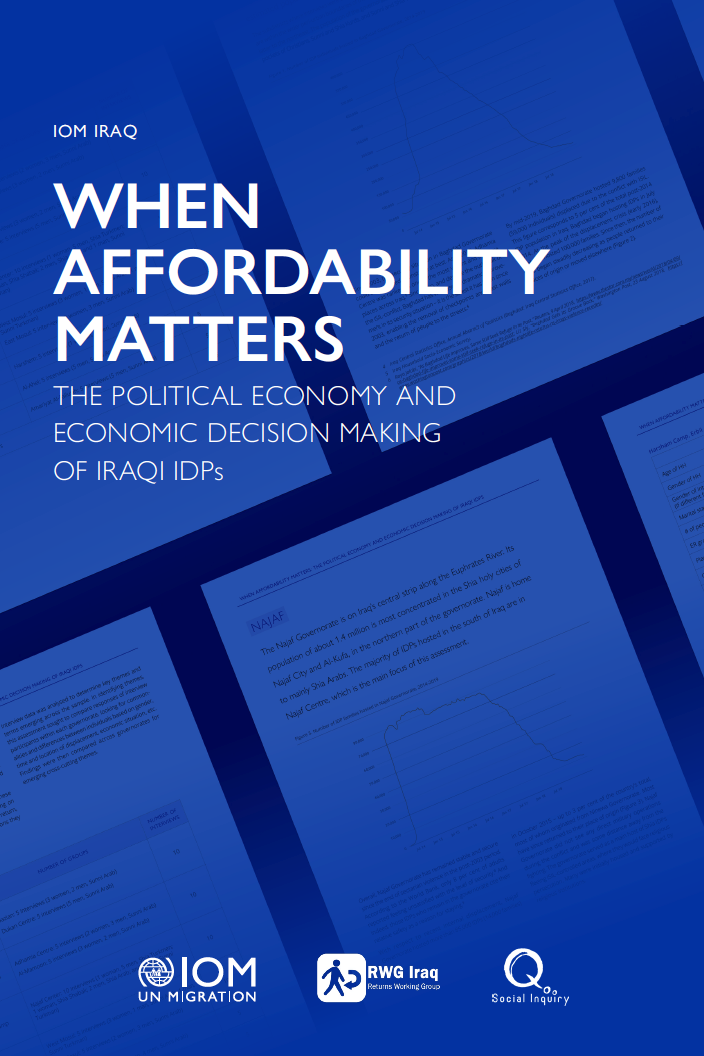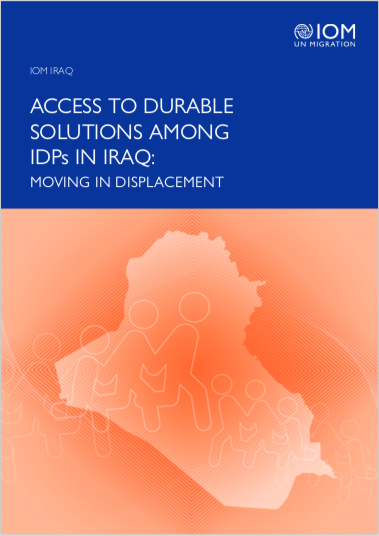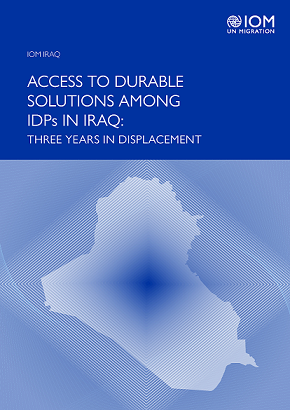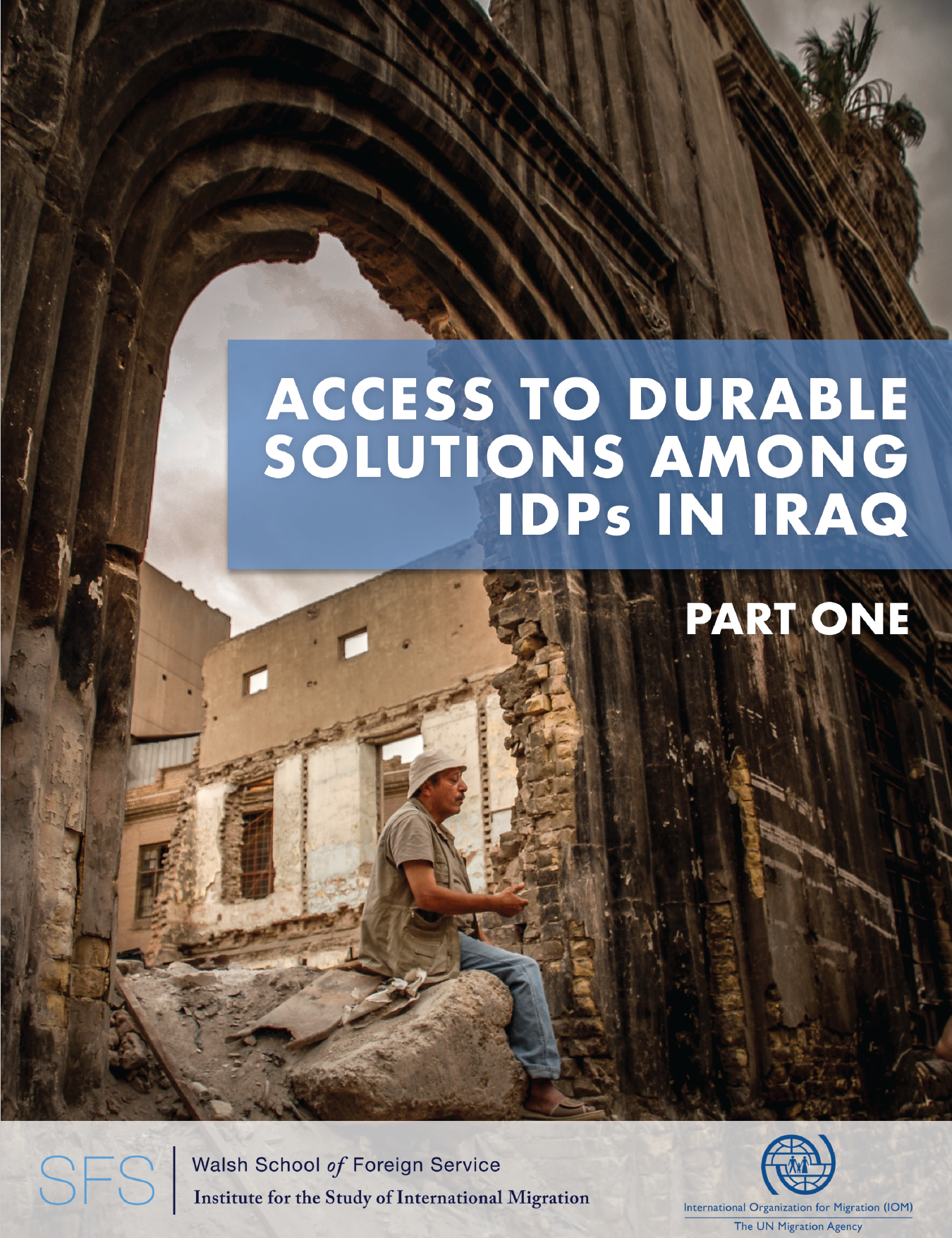ACCESS TO DURABLE SOLUTIONS AMONG IDPS IN IRAQ: SIX YEARS IN DISPLACEMENT
Since 2015, IOM Iraq and Georgetown University have implemented a longitudinal study, “Access to Durable Solutions in Iraq.” This study has consisted of surveying the same non-camp IDP families since they became displaced between 2014 and 2015 due to the ISIL conflict, with the aim of understanding how they navigate their displacement and take steps to build lasting durable solutions. Since 2017, the study has also surveyed some of these families who have returned to their area of origin. This is the sixth report in the series, and analyzes the extent that families face challenges in realizing a durable solution in line with the criteria of the Inter-Agency Standing Committee (IASC) framework: safety and security; standard of living; livelihood and employment; housing, land and property; personal and other documentation; family reunification; access to justice; and participation in public affairs. Additionally, it includes comparative analysis with previous rounds, and details how the COVID-19 pandemic has affected the ability of IDPs to achieve a durable solution.
View and download COVID-19 Factsheet
MANAGING RETURN IN ANBAR: Community Responses to the Return of IDPs with Perceived Affiliation
In Anbar, nearly half a million people fled the ISIL advance between January and May 2014. A second wave of displacement took place in 2016 when the military campaign to expel ISIL reached the area. As of December 2019, over 1.4 million people have returned to Anbar, where tension exists between those who displaced during the initial advance of ISIL and those who initially remained and displaced at a later period. Although some communities have advanced towards a more nuanced understanding that having cohabited with ISIL does not necessarily imply affiliation, community members with family or tribal ties with those accused of having an affiliation continue to be perceived as sympathizers of the group. In some instances, returned IDPs with perceived affiliation have secondarily displaced after having been rejected by their communities of origin.
HOUSING, LAND AND PROPERTY RIGHTS IN IRAQ: District-Level Factsheets Assessing Progress Towards Durable Solutions in Line with the Pinheiro Principles
These district profiles include a range of key HLP information related to return dynamics, protracted displacement and shelter type. Each profile also includes a range of quantitative indicators in a HLP monitoring framework in line with the Pinheiro Principles. A total of 18 profiles are included, including the top 15 districts of return, as well as three additional districts which are the focus of HLP activities coordinated by the Durable Solutions Technical Working Group (DSTWG).
HOUSING, LAND AND PROPERTY RIGHTS IN IRAQ - AN ASSESSMENT OF PROGRESS TOWARDS DURABLE SOLUTIONS IN LINE WITH THE PINHEIRO PRINCIPLES
View and download kurdish version of HOUSING, LAND AND PROPERTY RIGHTS IN IRAQ - AN ASSESSMENT OF PROGRESS TOWARDS DURABLE SOLUTIONS IN LINE WITH THE PINHEIRO PRINCIPLES
ACCESS TO DURABLE SOLUTIONS AMONG IDPs IN IRAQ: LIVELIHOODS AND ECONOMIC SECURITY IN DISPLACEMENT
Access to Durable Solutions Among IDPs in Iraq: Livelihoods and Economic Security in Displacement focuses on IDPs and returnees’ opportunities for livelihoods, and its effects on their ability to make ends meet.
Overtime in displacement, livelihoods has become the main factor for the interviewed IDPs when consider returning to their places of origin. Without the infrastructure of a functioning economy and livelihood opportunities to return to, IDPs are choosing to stay in host communities where they see more economic security, even if tenuous or temporary. Nearly all IDP households in the non-camp population to which the study generalizes reported having an income from a job, but the plurality obtains it from the informal sector—one that provides little long-term security. IDPs often go into debt to make ends meet, prolonging the effects of their displacement. Families overall change their consumption patterns in displacement and larger IDP families (10 or more members) live below the UN Iraq-defined poverty line.
This report is part of a larger panel study on “Access to Durable Solutions Among IDPs in Iraq” implemented since December 2015 by IOM Iraq in partnership with Georgetown University. The study has followed 4,000 displaced families living outside of camps who were displaced by ISIL between January 2014 and December 2015 and displaced to Basra, Baghdad, Sulaymaniyah and Kirkuk.
ACCESS TO DURABLE SOLUTIONS AMONG IDPs IN IRAQ: FIVE YEARS IN DISPLACEMENT
IOM has implemented a longitudinal study on entitled “Access to Durable Solutions Among IDPs in Iraq” since 2015 in partnership with Georgetown University in order to understand how IDPs navigate their displacement and take steps to build lasting durable solutions. This study draws from the Inter-Agency Standing Committee (IASC) framework on Durable Solutions for IDPs, which lays a foundation for government and humanitarian actors to better address the self-identified needs of IDPs.
While previous reports from this study have featured the longitudinal component of the study, this report entitled Access to Durable Solutions Among IDPs in Iraq: Five Years in Displacement provides a brief update on the eight criteria and then delves more in-depth into three critical topics relating to IDP and returnee households: education, healthcare, and justice.
The study offers insight into the challenges and survival strategies of Iraqi IDP families who were displaced by ISIL between January 2014 and December 2015 to the four governorates of Baghdad, Basra, Kirkuk, and Sulaymaniyah. This mixed-method project collected four rounds of data to analyze how the same 4,000 Iraqi IDP households displaced during this period attempt to access sustainable solutions to their displacement.
ACCESS TO DURABLE SOLUTIONS AMONG IDPs IN IRAQ: Unpacking the Policy Implications
The policy report also summarizes the main findings emerging
from the five rounds of data collected to date. The study, which began in 2015,
has followed 4,000 out-of-camp IDP households who were displaced originally to
Basra, Baghdad, Sulaymaniyah and Kirkuk by ISIL between January 2014 and
December 2015.
ACCESS TO DURABLE SOLUTIONS AMONG IDPs IN IRAQ: Experiences of Female-Headed Households
Access to Durable Solutions Among IDPs in Iraq: Experiences
of Female-Headed Households explores life in displacement of the subset IDP
families in the “Access to Durable Solutions Among IDPs in Iraq” panel study
conducted by IOM Iraq and Georgetown University. The study found that by early
2020, nearly five years after being displaced, female-headed households are
more likely to still be in displacement than male-headed households. To meet their
basic needs, female-headed households reduce food and other expenses, and
borrow money from family and friends. In addition to loans, they also rely on
family, neighbors, and friends for housing, food, other expenses, as well as
emotional support, transportation, and child and elder care. In terms of
working to help meet their needs, the study found that female-headed households
are not likely to enter the workforce because of a relatively high rate of
illiteracy. Women with low levels of education express that they lack the
skills to work outside the home. Some women expressed they benefited from
training programs to augment their ability to earn income. Women also expressed
desire for other opportunities, such as microloans, to improve their income. The
ongoing study began in 2015 and has followed 4,000 displaced families living
outside of camps who were displaced to Basra, Baghdad, Sulaymaniyah and Kirkuk.
ACCESS TO DURABLE SOLUTIONS AMONG IDPS IN IRAQ: EXPERIENCES APPLYING TO COMPENSATION
Access to Durable Solutions Among IDPs in Iraq: Experiences Applying to Compensation delves into self-reported levels of damage to housing and property among IDPs and sampled returnees and their experiences with the compensation process.
IDPs’ knowledge of the compensation claim process increased significantly between 2016 and 2018, with IDPs and sampled returnees who have higher damage to their property being more likely to apply. Despite greater knowledge about the process and an increase in compensation claims submitted by both IDPs and sampled returnees, the process is still considered complicated and lengthy. Also, most IDPs and sampled returnees are only aware of and have applied to compensation for Housing, Land and Property claims but remain unaware of other compensation categories such as compensation for dead or missing family members.
A majority of both IDP and sampled returnee families who have applied have not received a verdict on their application. Among those whose claims were rejected, the main reason given was that the application lacked necessary documents, such as police reports and proof of damage.
The findings of this brief report are part of the “Access to Durable Solutions Among IDPs in Iraq,” a longitudinal study implemented since December 2015 by IOM Iraq in partnership with Georgetown University. The study has followed 4,000 displaced families living outside of camps who were displaced to Basra, Baghdad, Sulaymaniyah and Kirkuk.
RURAL AREAS IN NINEWA: LEGACIES OF CONFLICT ON RURAL ECONOMIES AND COMMUNITIES IN SINJAR AND NINEWA PLAINS
This report focuses on the impact conflict has had on agriculture and displacement prior and during the ISIL crisis in Al-Hamdaniya, Tilkaif, Baashiqa, and Sinjar, predominantly rural areas. The findings of this report are relevant for stabilization purposes and strategies around the return of IDPs originally from these areas and the restart of agricultural activities upon their return.
WHEN AFFORDABILITY MATTERS: THE POLITICAL ECONOMY AND ECONOMIC DECISION MAKING OF IRAQI IDPS
This study by IOM Iraq, Returns Working Group (RWG), and Social Inquiry delves into the various issues and challenges that IDPs consider when assessing the affordability of return, and accordingly, the calculations they make when considering whether or not to remain in displacement.
According to the report findings, affordability is less an economic calculation than a holistic concept comprised of multiple factors that determine safety and wellbeing. While barriers to return, such as destroyed housing and inadequate economic opportunities, are critical components of affordability, it is crucial also to consider the tenuous yet viable networks and safety nets constructed by IDPs in displacement that also contribute to their decision to remain. The notion of overcoming not only financial losses but destroyed social resources and stressful memo¬ries all factor into the analysis that IDPs make when they consider the affordability of return. Thus, the interviewed IDPs understand affordability based on perceptions of conditions at home as well as the resources and mitigation measures available in areas of displacement.
Understanding the context behind an internally displaced person’s (IDP) stated financial inability to return helps to elucidate their reasons for not returning, as well as the impact of other related political and economic factors on their decision-making process and the pursuit of durable solutions.
ACCESS TO DURABLE SOLUTIONS AMONG IDPS IN IRAQ: FOUR YEARS IN DISPLACEMENT
IOM has implemented a Longitudinal Study on Durable Solutions for IDPs in Iraq since 2015 in partnership with Georgetown University (Washington DC, the United States) in order to understand how IDPs navigate their displacement and take steps to build lasting durable solutions. This study, entitled “Access to Durable Solutions Among IDPs in Iraq” draws from the Inter-Agency Standing Committee (IASC) framework on Durable Solutions for IDPs, and lays the foundation for government and humanitarian actors to better address the self-identified needs of IDPs.
The study offers insight into the challenges and survival strategies of Iraqi IDP families who were displaced by ISIL between January 2014 and December 2015 to the four governorates of Baghdad, Basra, Kirkuk, and Sulaymaniyah. This mixed-method project collected four rounds of data to analyze how the same 4,000 Iraqi IDP households displaced during this period attempt to access sustainable solutions to their displacement. Many of these families remain in displacement, some have returned, and others have moved to alternative locations.
This report delves into the progress made by IDPs remaining in displacement as well as sampled returnee populations now residing in their areas of origin. It offers key findings related to eight aspects of durable solutions to displacement: 1. Safety and Security, 2. Standard of Living, 3. Livelihood and Employment, 4. Housing, Land and Property, 5. Documentation, 6. Family Separation/Reunification, 7. Participation in Public Affairs, and 8. Access to Justice. By analyzing the changes IDPs have experienced and the tactics they employ over four years in each of these categories, the report reveals remaining challenges and promising avenues of support to best address the needs of IDPs.
ACCESS TO DURABLE SOLUTIONS AMONG IDPS IN IRAQ: MOVING IN DISPLACEMENT
IDPs who change location of displacement but do not return to their district of origin move to find jobs and secure livelihoods, supported by their family networks. They may visit their original homes, but the vast majority have not tried to live in them again. Some are “in process” returnees, meaning they have returned to areas very close to their original homes. They have also witnessed higher levels of damage to their housing, land and property than returnees; they may want to return home but cannot do so because their homes are too badly damaged.
The Access to Durable Solutions Among IDPs in Iraq: Moving in Displacement report offers key insights into the particular challenges faced by IDP “movers”.
IOM Iraq, in partnership with Georgetown University, has been implementing a Longitudinal Study on Durable Solutions for IDPs in Iraq since December 2015. The study has followed 4,000 displaced families living outside of camps who were displaced to Basra, Baghdad, Sulaymaniyah and Kirkuk; this report is part of the study.
IOM IRAQ ACCESS TO DURABLE SOLUTIONS: THREE YEARS IN DISPLACEMENT
IOM Iraq, in partnership with Georgetown University (Washington DC, the United States), has been implementing a Longitudinal Study on Durable Solutions for IDPs in Iraq since 2015, to deepen the understanding of durable solutions to internal displacement. The study, which is based on the Inter-Agency Standing Committee (IASC) framework on Durable Solutions for IDPs (2010), aims to understand how IDPs navigate over time their displacement and what it means to them to achieve durable solutions. The solutions IDPs identify themselves can in turn be adopted and supported by government and humanitarian actors alike to better address their needs.
This study offers key insights into the challenges and survival strategies of Iraqi IDPs who were displaced by ISIL between January 2014 and December 2015 to the 4 governorates of Baghdad, Basra, Kirkuk, and Sulaymaniyah. A sample of 4,000 displaced families living out of camps were enrolled in the study in December 2015 and they have been interviewed four times since. Many of these are still displaced, others have returned to areas of origin while some have moved to other locations.
The collaboration with Georgetown University has led to a joint publication of the Access to Durable Solutions Among IDPs in Iraq (capturing the findings of Round I) report in 2017, as well as the joint International Conference on Migration and Displacement in Iraq (2017) in partnership with the University of Kurdistan Hawler (UKH), which offered a platform for dialogue on durable solutions for Iraq’s displaced population. A forthcoming special edition of the International Migration Journal
will gather the academic articles that resulted from the conference.
ACCESS TO DURABLE SOLUTIONS AMONG IDPS IN IRAQ - PART ONE
More
than four million Iraqis live as internally displaced persons (IDPs),
comprising over 10% percent of the country’s population of
36 million. Repeated rounds of internal displacement have plagued Iraq for
decades, most recently with the rise of the Islamic State of Iraq and the
Levant (ISIL) and the subsequent fighting.
This
longitudinal study by the International Organization for Migration (IOM) and Georgetown
University identifies the ways in which Iraqi IDPs experience displacement,
adapt to their circumstances, and create durable solutions. Through surveys of
about 4,000 Iraqi families displaced since January 2014, and qualitative
interviews with host communities and IDPs, the study aims to help researchers
and policymakers build more accurate and nuanced understandings of IDPs’
realities in order to foster more effective durable solutions.
